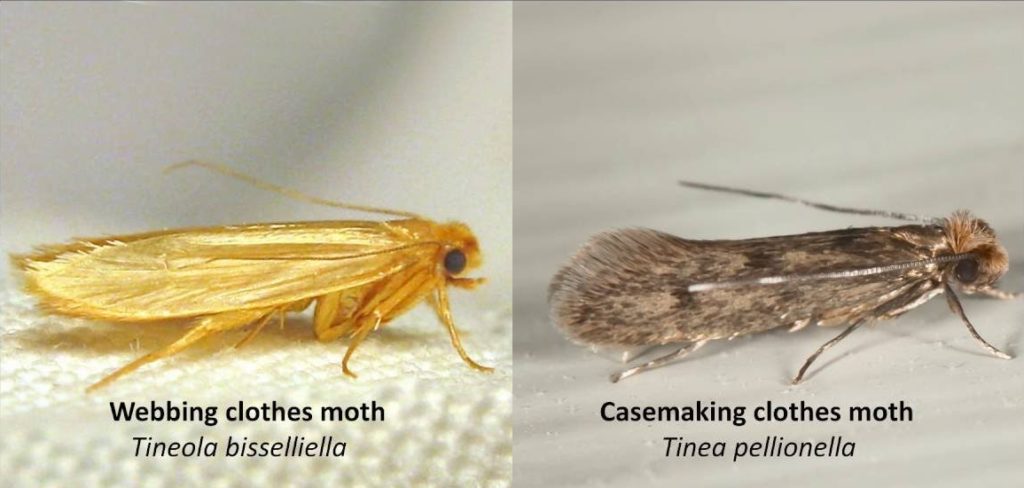One of the biggest threats to the integrity of your cherished area rug are moths. Many people assume that the widespread use of synthetic fibers in carpets and rugs has made moth damage a thing of the past — which is an incorrect assumption.
Clothes moths can digest protein fibers such as wool and silk, but these insects will also eat protein substances on synthetic fibers. This means carpets, rugs and upholstery made from nylon, acrylic, polyester, acetate, and other synthetic materials can be infested by moths if they contain food or drink stains, blood, urine, perspiration or other sources of nutritional protein.
If your rug has an abundance of dog or cat hair on it, it is particularly susceptible to moth infestation.
What are Moths?
A clothes moth feeds on keratin, a fibrous protein that the worm-like larvae can digest. The adults lay eggs on products such as wool rugs that the larvae will consume. Each female moth can lay 100-150 eggs that hatch in about five days. The larval stage can last anywhere from two to 30 months.
Rugs are a major source of food for a moth. Depending on the food supply, the life cycle of a moth can range from two months to 2 1/2 years. The adult moths actually cause no damage. It is their larvae they produce that consume the keratin and rug fibers.

In the Pacific Northwest, our technicians come across two types of rug moths. Both types are clothes moths, but also attack your home’s rugs.
- Webbing moth (Tineola bisselliella). The adult webbing moths are about a half-inch long and yellowish beige in color. The webbing moth larvae attach their tubes to dark crevices or seams, and they are stationary and feed in one location.
- Casemaking moth (Tinea pellionella). The adult casemaking moths are about a half-inch long and brown in color. They have three dark spots on their forward wings. The casemaking moth’s larvae do not attach their tubes (cases) allowing them to move around and cause more damage than the webbing moth.
Common Signs of Moth Damage
Wondering if you have moth damage in your rugs? Look for these signs:
- Sticky substance. A common sign of moth larvae is a sticky substance that looks like spiderwebs on the back side of your rug.
- Bare spots or holes. Moth larvae will eat the pile right out of the foundation of your rug.
- Cocoons. Moth cocoons are slightly fuzzy cylinders about ⅛ inch in diameter and ½ inch long. The larvae camouflage their cocoons to blend in with the color of the rug.
- Grainy coating. The presence of grainy, light to dark brown excrement on the pile of the rug is a sign of moth damage.
Our Moth Restoration Process
If you notice that your rug has been infested with moths, the easiest thing to do is contact Fuzzy Wuzzy. A technician will come to your home free of charge to inspect the rug and bring it in for treatment.
If your rug is infested, we will first have it treated with insecticide. The most effective and safe insecticide is pyrethrum, an extract made from dried chrysanthemum flowers. During the fumigation process, the pyrethrum rapidly paralyzes the moth’s nervous system, eliminating the infestation.
After fumigation, we will put your rug through the same deep cleaning process that all our rugs go through. This includes a full submersion cold water bath that is designed to maximize cleaning results while protecting sensitive fibers.
After drying and cleaning is complete, your rug is inspected for damage. If you opt to have your rug repaired from any moth damage it would be done at this time.
If you have any questions about our moth damage restoration process, contact Fuzzy Wuzzy at 206-525-0058.
How to Prevent Moth Infestation
Keeping your rugs clean is the most effective way to prevent moth damage. Remove spills immediately and clean thoroughly. Rugs should be vacuumed or brushed regularly, as moths do not generally attack clean materials.
Place your rug on a quality pad. This eliminates air spaces between the rug and floor, making it harder for the pests to settle in.
The experts at Fuzzy Wuzzy recommend that you have your rugs cleaned regularly by a professional cleaner (every 1-2 years). While you want to keep your most high-profile rugs clean, the rugs that are in rooms that are used infrequently are at the highest risk for moth infestation.
If you are going to store your rug for any length of time, make sure it is properly cleaned beforehand.